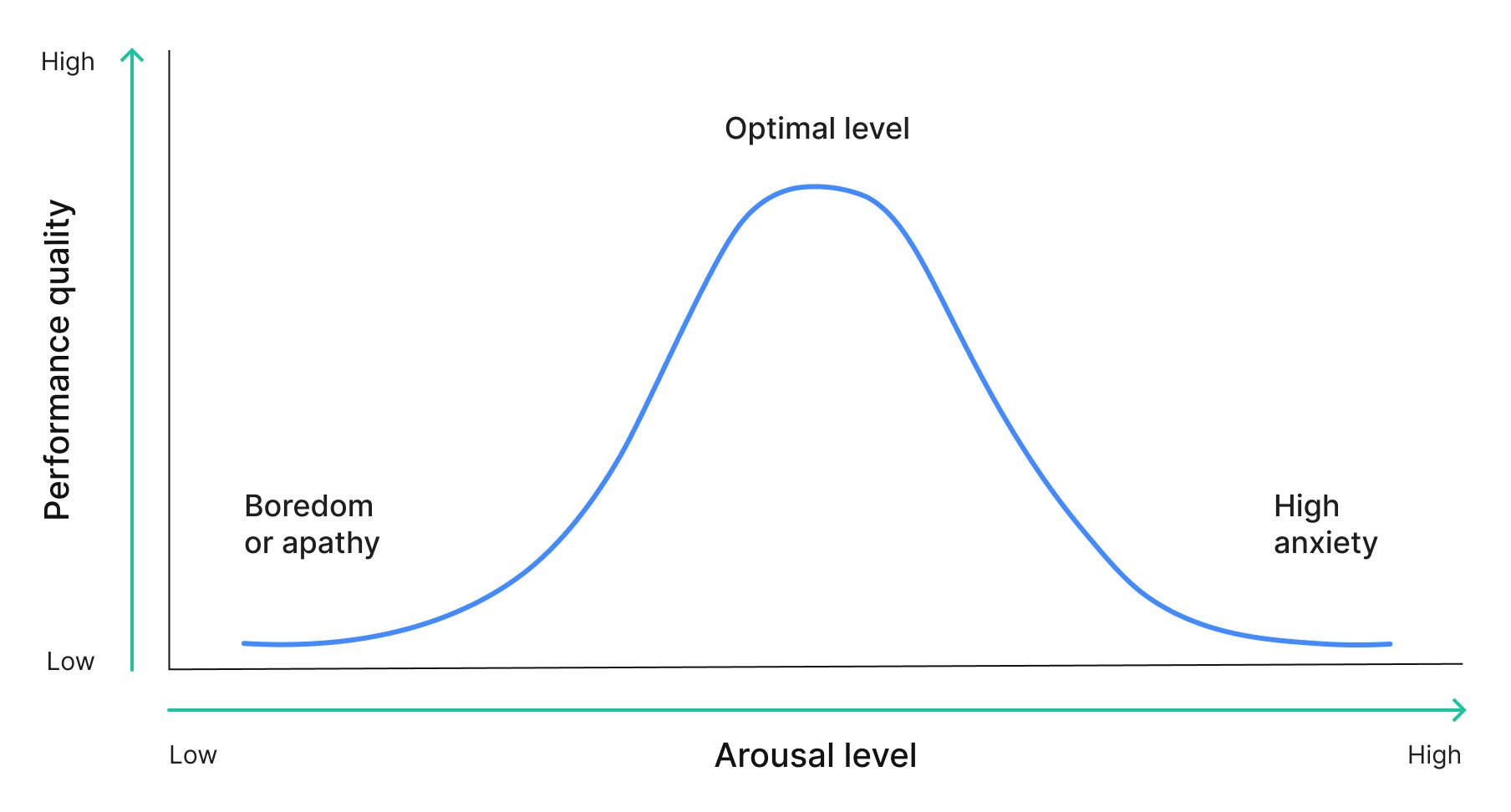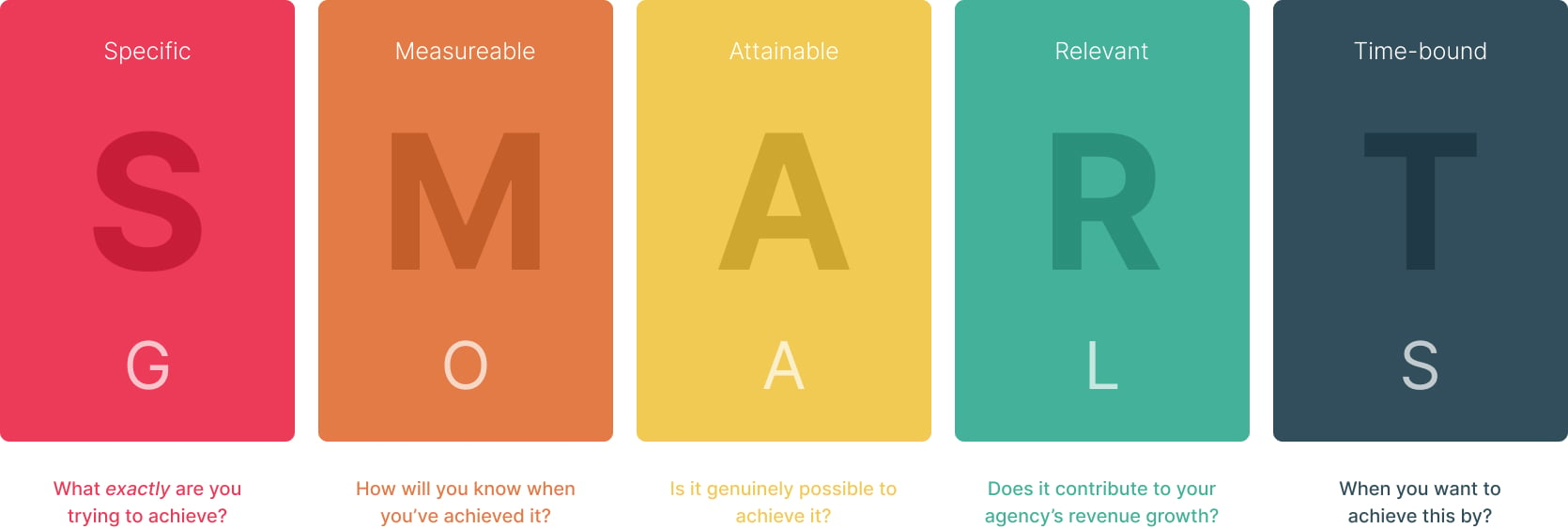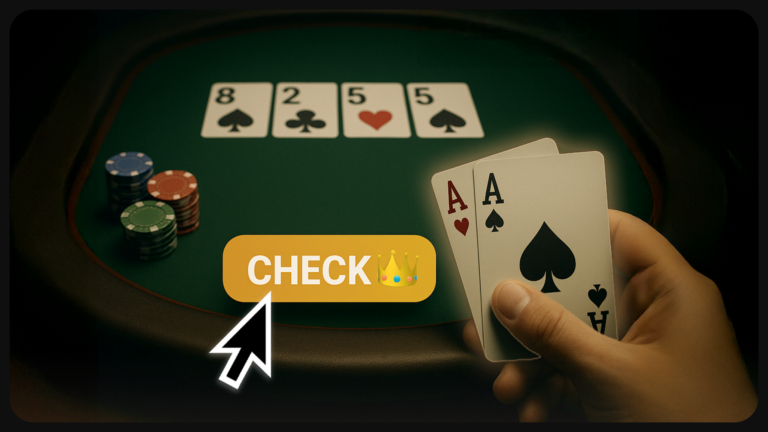The Science of Poker Performance
Emotions and Poker
Poker is a game of small edges and big swings. Every hand is an investment into your edge. But the tidal waves of variance can easily overwhelm even the most seasoned players. In this article we’ll discuss the root causes of tilt, emotional awareness, and how to improve your mental game.
Mental Game Matters!
Performance in poker is not static – sometimes we play at a higher level, other times we play at a worse level. Playing your A-game more often and C-game less often is usually the fastest way to improve!
Let’s demonstrate this with some simple math. We’ll pretend that we have three states, the A, B and C game, with the following win rates:
- A-game = 6 BB/100 (Zoned in!)
- B-game = 3 BB/100 (Solid but autopilot)
- C-game = -2 BB/100 (Tilted/Suboptimal)
These categories are arbitrary, you could split it up using any number of letters. But the winrates assigned to them are extremely generous. Many players lose much more than 2BB/100 when tilted!
Scenario 1: 30% of our volume is suboptimal
Scenario 2: 10% of our volume is suboptimal
Just shifting 20% of your volume from C to A nearly doubles your win rate! This is why mastering your emotions is an imperative skill in poker, and one of the fastest ways to improve quickly.
Chapter 1: The Science of Performance
So if maximizing performance is such low-hanging fruit, why is it so often neglected?
Unlike poker, your mental game is not easy to measure. There are no solvers for tilt. Mental health is easy to neglect, and developing the emotional intelligence required to perform well is as much a skill as developing poker technique. It requires introspection, it requires addressing issues that we subconsciously ignore.
Let’s dive into the science of it so we may better understand what drives optimal performance.
The Zone
Many performance specialists state that “the zone” is a state of flow whereby a person is fully immersed in what they’re doing. The zone is your A-game, so we need to try and define it.
- You are totally engrossed and in the flow of the action.
- You don’t experience any outside thoughts or distractions.
- You’re focused purely on execution and not results.
- Altered sense of time.
- Any thoughts of the past or future are purely strategic.
How does one get into the zone though?
- You need the optimal level of stress.
- You need to be sufficiently challenged without becoming overwhelmed.
- Your physical needs have to be met.
Stress levels
Many players are too invested in their results, which creates tilt and prevents them from separating the process from the outcome. Placing too much emotion on the results of a poker hand is bound to end poorly. Emotional excess impedes logical thoughts and decreases quality of play.
Some players try to counter this by turning into “poker zombies” and removing emotion from the equation entirely. This approach is not optimal either. Emotional disconnection makes motivation difficult and decreases quality of play.
So what is the correct amount of emotion? 🤔
The Yerkes-Dodson Law proposes that there is an optimal level of stress between a zombie and a nervous wreck. The optimal level of stress depends on the complexity of the task.

As always, there’s a middle ground. You need to be emotionally invested enough to retain your motivation and drive, yet relaxed enough to avoid tilt and maintain the ability to separate the process from the outcome.
Degree of challenge
Playing as an underdog (low skill) in a very challenging game causes anxiety. Conversely, a very skilled player against weak competition may lose flow due to overconfidence and boredom. Psychologist Mihaly Csikszentmihalyi argues that flow state of the zone is generated when your skills are sufficiently challenged without being overwhelmed.

Experienced poker players may feel boredom when it comes to grinding. It may feel like a chore or a job. That feeling will hinder your performance, as you’re no longer able to stay in flow. It’s important to try and maintain focus to stay in the zone while you’re playing. Even when not in a hand, pay attention to what the other players are doing.
The Vicious Cycle
Accumulated stresses from work, relationships, results and life in general all contribute to emotional fatigue. These stressors can build up over time.
Moreover, we often adopt poor habits as crutches to deal with these stressors. It becomes easy to neglect your sleep, routine, nutrition, and health, which only reinforces your long-term stress. This vicious cycle is especially common among poker players.
The most dangerous part of this cycle is that you can become trapped in a state of perpetual fatigue. When you feel like crap for long enough, you’ll forget what being well is supposed to feel like. You’ll become accustomed to always feeling tired and worn out. You will get trapped in your “C-game”, without even realizing it.
Establishing a daily routine is paramount!
A routine can be as simple as your morning ritual, what time you wake up, work, eat, and go to bed. Sticking to a routine will improve your sleep, your eating habits, your stress, and your time effectiveness. Many studies have shown that a daily routine is strongly correlated with better mental and physical health.
Building a Poker Training Routine
In addition to maintaining a reasonably healthy lifestyle, you should build a poker training routine.
A solid routine involves:
- Intentional, deliberate practice
- SMART goals
- A checklist of activities to complete
- Dedication over the long-term
S.M.A.R.T. goals should be Specific, Measurable, Attainable, Relevant, and Time-bound.
A lot of the goals we set for ourselves are V.A.P.I.D. goals. Vague, amorphous, pie in the sky, irrelevant, delayed.
Here’s an example:
- Smart Goal: “I will practice 4bet pots, IP, for two hours every week, until I can regularly achieve a GTOW score of 95% in the trainer.”
- Vapid Goal: “I will memorize the strategy for every 4bet pot in every spot, I don’t care how long it takes!”
The four stages of competence
The four stages suggest that individuals are initially unaware of how little they know, or unconscious of their incompetence. As they recognize their incompetence, they consciously acquire a skill, then consciously use it. Eventually, the skill can be utilized without it being consciously thought through: the individual is said to have then acquired unconscious competence.
- Unconscious incompetence (Ignorance)
You don’t know what you don’t know. Therefore, you can’t recognize your own incompetence. - Conscious incompetence (Awareness)
You recognize your lack of competence. - Conscious competence (Learning)
You can use the skill with concentration and effort. - Unconscious competence (Mastery)
The skill has become second nature.

As the philosopher Socrates once said,
I know that I know nothing.
The first step to mastery is recognizing that there are things you don’t even know you don’t know. If you want to improve at poker, you need to accept that there may be strategic facets to this game you had never even considered.
Chapter 2: Identifying and Overcoming Tilt
The Seven Types of Tilt (according to Jared Tendler)
Tilt means playing suboptimally due to emotional reasons instead of logic. Everyone experiences tilt. The Mental Game of Poker outlines seven types of tilt. Learning to recognize these types of tilt and how to deal with them is crucial to maximizing your performance.
(Credit: The Mental Game of Poker by Jared Tendler)
Running bad tilt:
Every human player experiences bad runs. This is a natural part of the game. But the tilt that comes from running badly is a form of accumulated tilt that develops over time. When variance makes you tilt, you play badly, which makes you tilt more often, repeating the cycle.
To quote a section from The Mental Game of Poker:
A streak of bad variance doesn’t cause tilt. It reveals the underlying reasons you tilt.
If you aren’t sure which of the other types of tilt running bad exposes, your thoughts can help you to implicate them. For example:
- “This isn’t fair, I’m due to run normal, I never win a flip!” = Injustice Tilt
- “How is it possible to lose like this again!” = Hate-losing Tilt
- “I knew that! Dammit, how can I play so bad?!” = Mistake Tilt
- “I’m too good of a player for this to happen. How can I keep losing to this donkey?” = Entitlement Tilt
- “I’m gonna 3-bet this idiot; who does he think he is!? I shove.” = Revenge Tilt
- “I’ll stay here for a week if I have to win!” = Desperation Tilt
Injustice tilt
Injustice tilt is triggered by coolers and bad beats. But its more than that. This type of tilt takes route when you believe the poker gods have cursed you. Injustice tilt is what happens when you believe that poker is simply not just or fair towards you. You believe your luck is worse than the math suggests is possible. Some players go so far as to accuse poker sites or dealers of rigging the deck against them.
Injustice tilt often stems from being unable to conceptualize variance. This game is much swingier than you can imagine. Watch this video to learn more. All humans have an implicit bias where we remember losses more strongly than wins. That makes it easier to filter out good times, and pay extra attention to bad times.
Another source of injustice tilt stems from not properly tracking results, or not recognizing when we’re getting outplayed. It’s easy to confuse bad luck with bad play if you can’t tell the difference.
Identify the strengths and weaknesses of your game. Track your results, and evaluate your play using tools beyond intuition. Learn to recognize good and bad variance, and learn how to use a poker variance calculator to hone your expectations.

Hate losing tilt
Emotional response to losing triggers tilt even when understanding the variance at play
A form of tilt found in highly competitive people who simple hate losing. This type of player hates losing more than they enjoy winning. If losing a pot on an otherwise good session, or having one losing session on an otherwise winning month, sends you over the edge, you have Hate-Losing Tilt.
I HATE LOSING MORE THAN I LOVE WINNING.
The root cause of this tilt is overcompetitiveness and placing too much of your selfworth onto your results. Remember, money lost at the table is an investment in your edge. If you lost making profitable plays then your losses are temporary so long as you keep playing well. Take a step back.
Mistake tilt
Mistake tilt is the frustration you feel when reflecting on poor plays you’ve made in the past. Frustration comes from reflecting on past suboptimal plays. Do you find yourself making ‘obvious errors’ or realising the right way to have played the hand immediately afterwards? Mistake tilt is routed in the unconscious faulty assumption that perfect play will always lead to perfect results. It stems from equating money with skill. The way to address mistake tilt is to first accept that perfect play won’t bring you perfect results. While self reflection is useful and necessary, obsessing over mistakes is not healthy.

The root cause of mistake tilt is:
- Unrealistic expectations – Thinking or feeling that every cooler and crappy spot could have been avoided (this is obviously not true).
- Expecting Perfection – Being too hard on yourself for not playing like a poker god. Perfection cannot be attained all the time, and you need to recognize that.
- Inability to separate bad luck from bad play. Separate the process from the outcome. Just because you lost the pot doesn’t mean you made a bad play.
Entitlement tilt
Entitlement tilt occurs when you believe you “deserve” to win. For example, expecting your AA to always hold vs KK when this only occurs 80% of the time. Or thinking that you’re so much stronger than your opponent that you are entitled to the pot. Entitlement tilt is the idea that your skill or cards entitle you to win, when that’s not the case.
The problem isn’t that you believe you’re better than your opponents. It’s that you believe this entitles you to the pot, leading to overconfidence, arrogance, riskier plays, and ultimately tilt.
If you find yourself experiencing entitlement tilt, remember:
- Being more skilled does not entitle you to the pot.
- Having a stronger range does not entitle you to the pot.
- You may not recognize your opponent’s skill or strategy (maybe they’re deviating to exploit you)
- Address the lies you tell yourself to protect your ego.
Revenge tilt
Revenge tilt tends to be aimed at specific players. Maybe you feel targeted by some opponent, or feel that they’re trying to disrespect or single you out with their play. So you go out of your way to attack them. This causes you to change your strategy and react sporadically.
👊 REVENGE! 👊
- You’re no longer playing your A-game. You’re playing a strategy designed to attack someone.
- There’s a difference between calm logical exploitative tactics, and angry vengeful tactics.
- Check your ego. Stay in control. Weaponize patience.
Identify specific situations or players who cause you to surrender control of your normal strategy. Resolve the flawed reasons and improve the technical mistakes that led you there in the first place.
Desperation tilt
Desperation is hard to recognize in the moment. This type of tilt is what causes you to chase losses, overplay your bankroll, and take on way more risk than you should. Desperation tilt is arguably the most dangerous type of tilt as it can destroy your bankroll rather than your session. This is driven by the typical gambler’s fallacy of gambling to break even by taking higher risk lines or gambling outside your roll to get unstuck. It’s exacerbated by an inherent human bias to focus on the negative that assuages our ego. “I’m good but unlucky” causes less damage to our ego than “I’m not good enough”.

Desperation tilt is incredibly dangerous. If you regularly experience symptoms of desperation tilt you need to take immediate and non-negotiable steps to mitigate it:
- Have a sense of urgency – recognize desperation tilt before it becomes full blown.
- Set a strict stop loss – combine with other prevention methods for maximum effectiveness.
- Develop an emergency response – Shut down your session before it snowballs.
Other types of tilt
Below we cover other common types of tilt not addressed in the first Mental game book:
- Scared Money
This is a conscious decision to play defensively out of fear of losing money. Fix this by using proper bankroll management. - Winner’s Tilt
More common than people realize. When you run extremely well you’re more likely to take on tremendous risk and overplay your hands. Learn to recognize when you’re running hot and check your overconfidence. - Dissociation Tilt
A very common zombie-like autopilot state that leads to random button clicking and a lack of caution. - Distraction Tilt
Not giving your full attention to the game. Caused by multitasking (e.g. watching videos or on social media while playing). This prevents you from getting in the zone or playing your A-game. Give poker your full concentration! - Implicit Bias
Humans remember losses more strongly than wins. It’s much easier to recognize bad variance than good variance. This risk aversion is built into our subconscious mental framework. It affects all of our decisions. In poker, this often leads to placing too much mental energy on bad runs, and not recognizing good runs.
General Tips for dealing with tilt
Circle of Control
The Circle of control argues that you should focus your energy on things within your sphere of influence. Stop wasting energy on things out of your control. When it comes to poker:
- You cannot control the deck, but you can control your strategy.
- You cannot control your luck, but you can control how you react to luck.
- You cannot control your emotions, but you can take away the power they have over you.

Injecting Logic
There is no “one size fits all” solution to control emotions at the poker table. Jared Tendler recommends using the following strategy to overcome tilt:
- Recognize when you’re straying from logical thoughts
- Inject logic into your thought process
- Rationalize a sound strategy
Failing this, quit your session. Edges are small and a technically gifted player playing their c-game is unlikely to be winning.
Separate the process from the outcome
The most important takeaway is that your goal is to separate the process from the outcome. Did you play the hand well? Yes? That’s what matters. Do NOT be results oriented in poker.
Weaponizing Your Mental Game
In poker you never play your hand. You play the man across from you.
– James Bond, Casino Royale
A strong mental game provides just as much an edge if not more than a strong technical game. Once you learn to recognize what causes tilt you can also recognize when your opponents are tilting and how to capitalize on it.
Make no mistake, they are doing the same to you!
Example 1:
Your opponent nits up after losing a big pot.
This player fears losing more money
- Great target to run a big bluff against as their fear may cause them to overfold. Aggression beats scared money, just don’t overdo it.

Example 2:
Your opponent lost a big pot and is playing way too many hands trying to win back their money.
This player will continue too wide as they chase losses
- Against this opponent you should bet for thinner value and avoid bluffing, as they will call too often. Remember your bluffs won’t get enough fold equity, and your value will overperform. Patience!
- If they’re overly aggressive, tighten up, stop bluffing, and let them maniacly build the pot for you. Don’t call with static bluff-catchers unless you intend to call future streets as well.
Conclusion
Tilt affects all players. There’s no easy solution. The first steps to improving your mental game is learning to recognize the different types of tilt and addressing the underlying emotional fallacies that cause them. Only once you’ve dealt with your own tilt can you begin to weaponize your mental game.
Start bringing your A-game more often than your C-game. Below is a list of resources for further reading:
- The Mental Game of Poker – Jared Tendler
- The Mental Game of Poker 2 – Jared Tendler
- Peak Poker Performance
In summary
- Establish a lifestyle and training routine
- Do not neglect your mental or physical health
- Aim to get in the zone every time
- Learn to separate the outcome from the process
- Identify the emotional root-cause of different types of tilt
- Improve your ability to conceptualize variance
- Recognize your implicit biases
- Weaponize your mental game
Author
Tombos21
Tom is a long time poker theory enthusiast, GTO Wizard coach and YouTuber, and author of the Daily Dose of GTO.























































































































































































































































